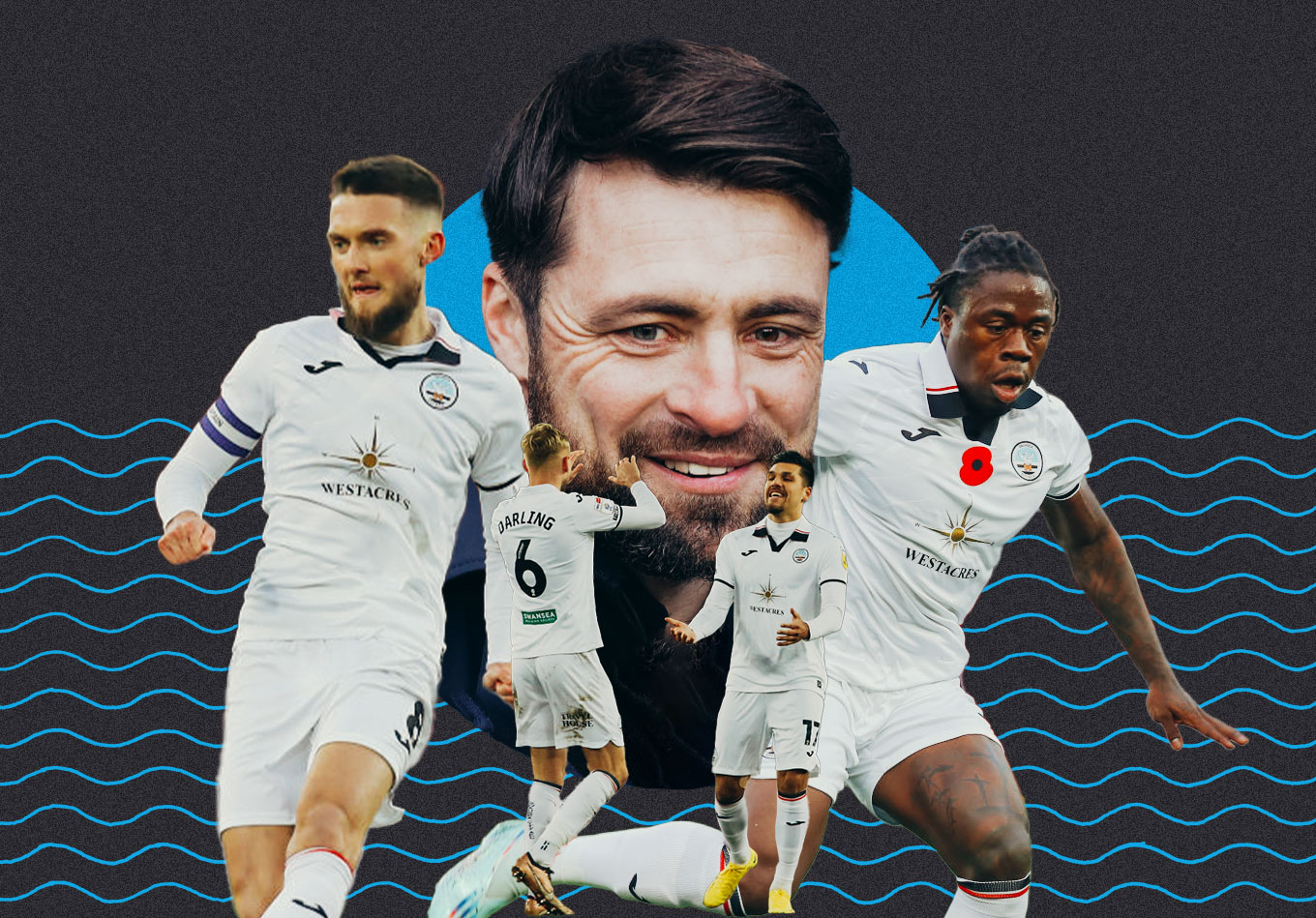Style and substance don’t always have to be mutually opposing ideals, yet it’s hard not to pay attention to the fact they’ve rarely existed in tandem for Swansea City.
The South Wales club are midway through their fifth successive season in the Championship, after relegation from the Premier League in 2018.
Their best achievements, results-wise, were the two play-off finishes under Steve Cooper in 2019-20 and 2020-21, losing to Brentford in the semi-final and final respectively.
And yet, their most appealing football came under Graham Potter in 2018-19 and arguably Russell Martin following his appointment in August 2021. Despite this, they finished 10th under Potter and 15th under Martin in his first season at the club, while they are currently 11th, albeit in a congested play-off scramble.
The swashbuckling Swans been one of the second tier’s most eye-catching outfits, yet they’ve conceded 38 goals in 28 games, more than Huddersfield in the relegation zone. The last team to win promotion from the second tier when conceding an average of at least 1.36 goals per game were Sunderland in 1989-90, so unless something drastic changes with Swansea’s defence in the last four months of the season, promotion via the play-offs looks out of the question.
So, do Swansea need to compromise the aesthetics for efficiency, or can Martin find the solutions without altering the style?
The Style
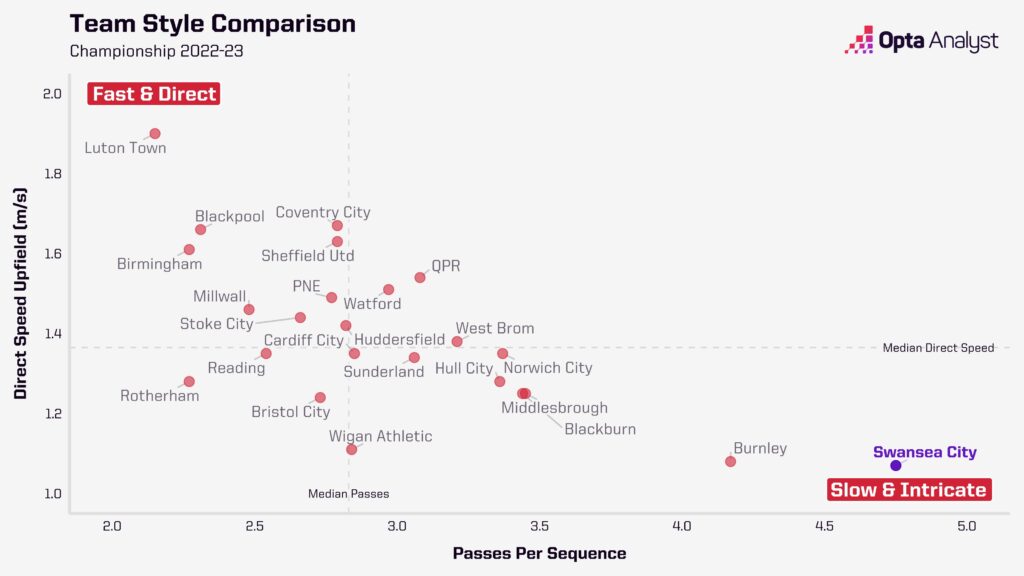
Martin will never compromise his style, having topped possession charts in his sides’ leagues for three seasons running – going back to 2020-21 at MK Dons.
And yet, defenders Harry Darling and Nathan Wood have talked up Martin’s flexibility when it comes to formation.
Since the World Cup interlude, his side have picked up performance wise, despite losing three in succession in that period – to Burnley, Norwich and Reading, all by a solitary strike.
Victories over Watford and Sunderland suggest a side building something, as well as the bouncebackability the group showed to recover a three-goal deficit at Coventry.
With this expansive style, the Swans have averaged 1.27 non-penalty expected goals in 2022-23, which is the fourth highest in the Championship, and with only four sides scoring more than their 40, Martin’s side are one of the most enterprising sides in the league.
The ‘Box’ Midfield
Darling, Wood and others have spoken about their belief in a new formation, 4-2-3-1, but in the second half of the 1-1 draw at QPR, Martin switched to a 3-4-2-1 once Olivier Ntcham replaced Joe Allen and Luke Cundle, Liam Cullen.
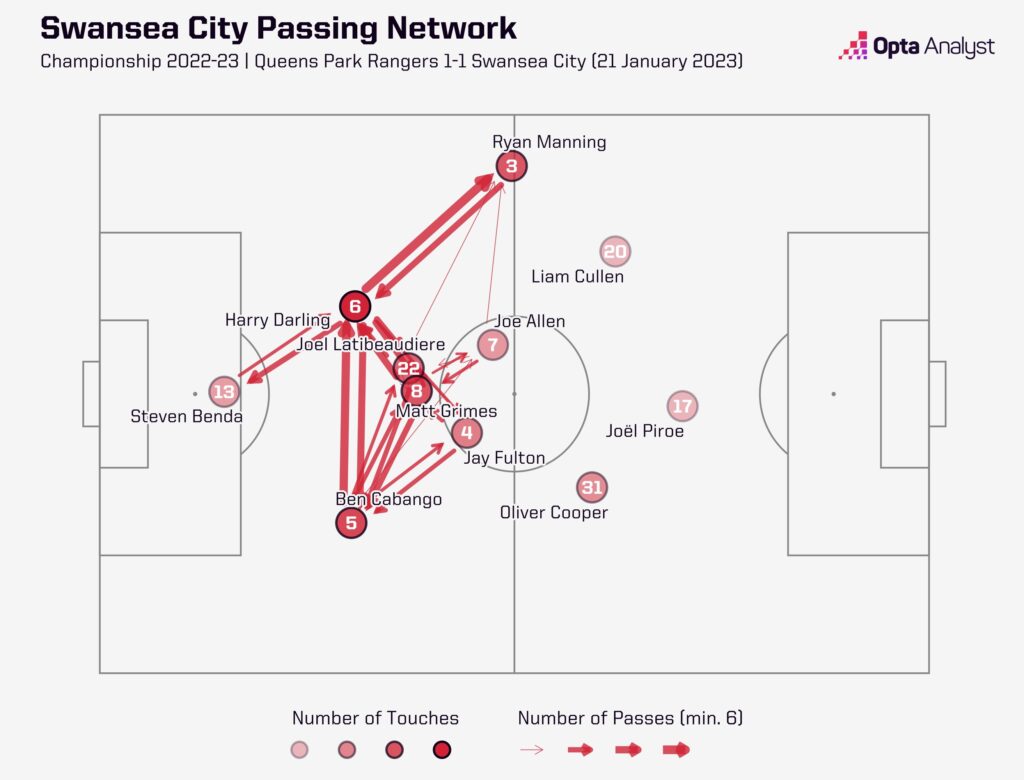
It’s a system Martin enjoyed success with at his former employers, especially with a midfield quartet of sitter Andrew Surman, tenacious ball-carrier David Kasumu, energetic all-rounder Matt O’Riley and creator Scott Fraser.
The danger with a back-four, for Swansea’s style, is that both full-backs need to be high up to provide width and when the No. 6 is drawn into advanced areas, it can leave two centre-backs very exposed to counter-attacks.
The back-three adds insurance, and allows Martin’s side to invite the press centrally, then pick out a right-sider, either Ntcham or Oli Cooper, which can open up the game within two passes.
Cooper would be classed as the right wing-back in a 3-4-2-1 on paper, but in truth the duo interchange in that role, because both are prepared to hug the touchline at certain moments. In fact, so is right centre-back Ben Cabango.
There are early phases of play in which Jay Fulton drops into defence to allow Cabango to become effectively a standard right-back, forging almost a straight line through Ntcham to Cooper on the flank.
This can be an effective method of beating a press because it’s difficult for them to target build-up play in the wide areas consistently, as they would then become vulnerable to the switch.
Swansea don’t quite have the same arrangement on the left side, because Latibeaudiere is more of an inverted wide centre-back than Cabango is on the right.
As such, what’s more common is rotation between Latibeaudiere and midfielder Matt Grimes, on paper the Swans’ left-sided No. 6.
Sometimes, Latibeaudiere will drift into midfield allowing Grimes to drop into defence, but only two players could be seen on the touchline rather than three.
Similarly to how Cooper and Ntcham know each other’s games inside out, Manning and Luke Cundle are working towards establishing the same kind of relationship.
Manning is not as delicate an operator as Cooper, Ntcham, or Cundle – he makes driving runs inside rather than more nimble and agile movements – although working with Martin has certainly smoothened some of his rougher edges.
As such, because Manning veers infield from the flank quicker than others might, it’s important that Cundle’s movement becomes a fraction sharper.
Sometimes Manning can drive infield and Cundle can expect Latibeaudiere to re-establish the width but when the Jamaican doesn’t, the Wolves loanee takes a few seconds longer to assume that remit, even if the opposing right-back has been forced narrow.
Swansea can still create chances from there, but it typically takes four passes to release Cundle where the aim is two: a lay-off and a quick, first-time switch.
However, there is clear progress in terms of the relationship between the two, which could come to the fore in the second half of the season.
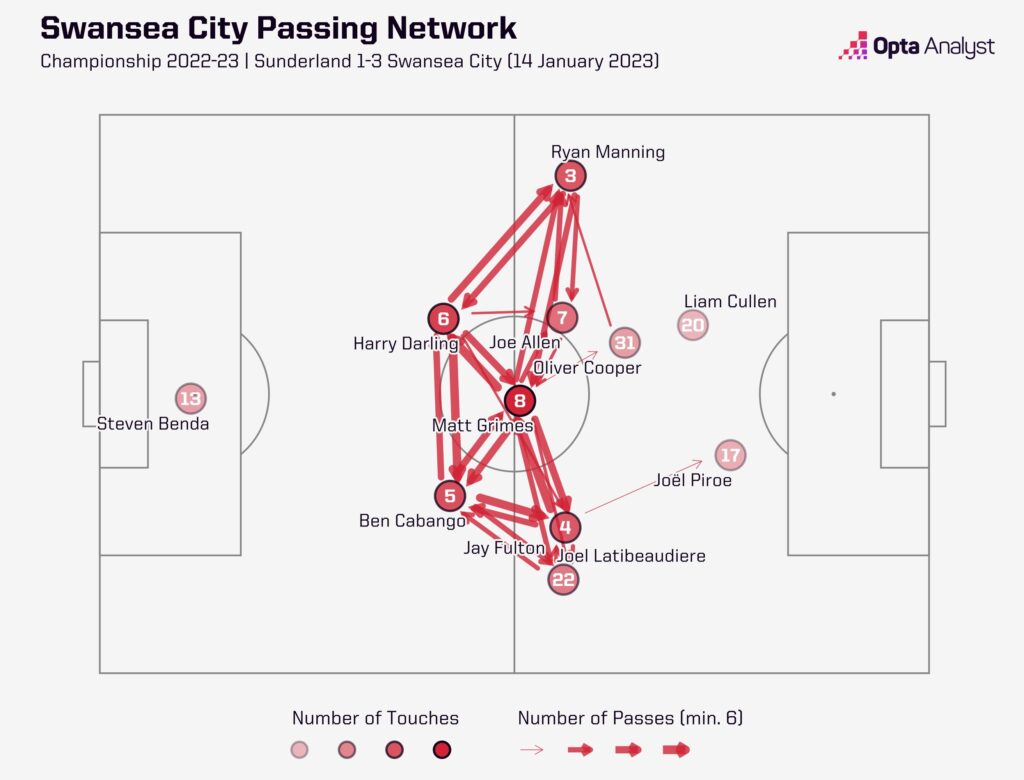
There is also a relationship between Cundle and Ntcham, thus Swansea can switch play easily: ideal when they’ve drawn the press and Darling or Grimes has been able to progress the ball into one of the two number eights.
Relationships are key to making this slick style work, but the box midfield allows Swansea to merge requirements for combinations out wide and central control.
With four central midfielders, the Swans should always have numbers in that department and, as a result of that insurance, there are opportunities for Cundle and Ntcham to explore, and forge partnerships elsewhere.
Calvin to Join?
Liverpool youngster Calvin Ramsay has made no secret of his ambition to break into the first team, but it’s been difficult to even get into the squad.
On the one hand, he’s competing with Trent Alexander-Arnold and, even not quite on top form, the former Premier League and Champions League winner is difficult to displace.
Perhaps more problematic for Ramsay is that when Alexander-Arnold hasn’t played for the Reds, it’s been 37-year-old James Milner, rather than him, getting the nod at right-back.
The Scot played three minutes against Napoli in the Champions League in November, then started the penalty shootout EFL Cup victory over Derby in the same month but has only since featured for the U21s.
As such, the £6.5 million recruit, who signed even after a back injury was discovered during the medical, may need half a season on loan in the Championship to prove his worth to Jürgen Klopp.
A quality right wing-back could make a real difference to Swansea because, as much as Cooper has adjusted to the role brilliantly, he’s not a natural.
Ramsay would be a natural fit, both for the position and style. In his EFL Cup outing for the Reds, the 18-year-old played 105 passes – of which 99 were successful – created one chance and had two efforts at goal.
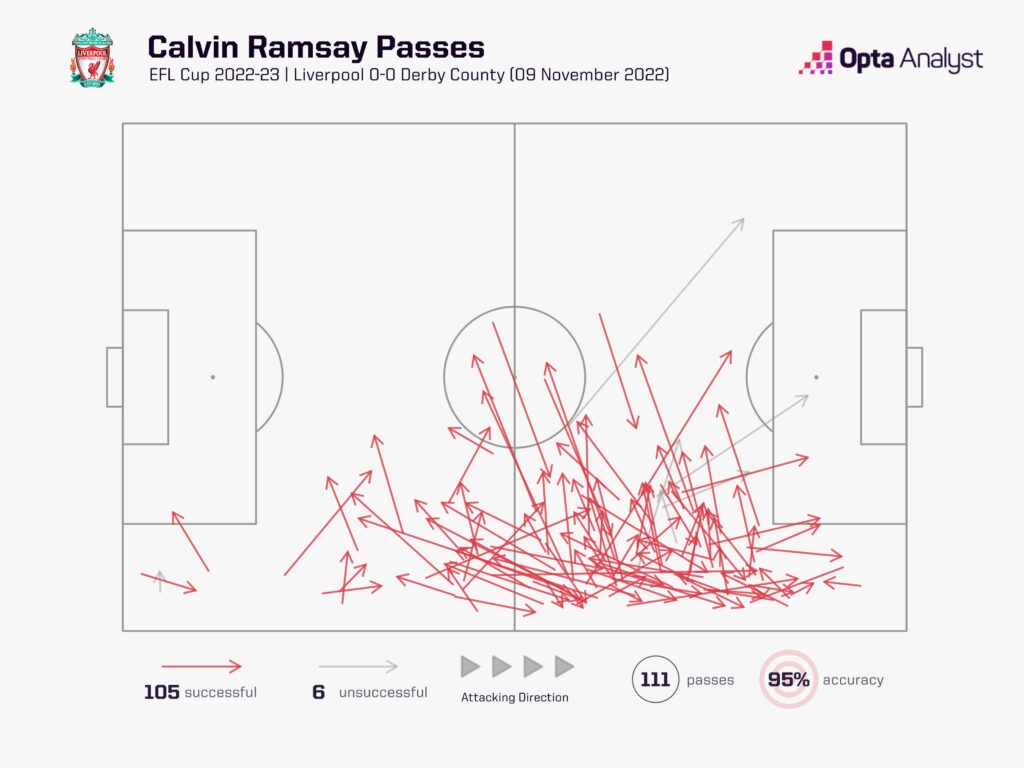
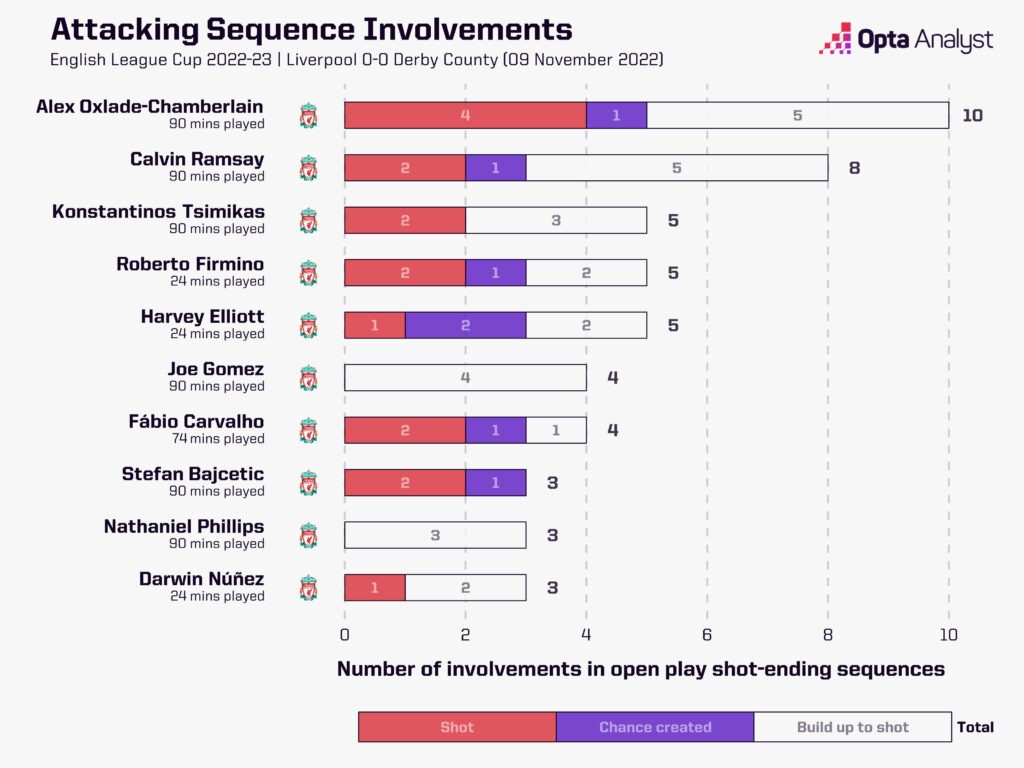
Being confident on either foot, Ramsay likes a first-time shot, and would be ideal for getting on the end of free-flowing moves.
At the same time, he’d be capable of bringing his attacking quality into some inverted runs, allowing him to dovetail with Cooper or Ntcham as the right-sided No. 10, adding to Swansea’s unpredictability in build-up play.
Plus, the 18-year-old has high stamina, meaning he can reclaim his position quickly in the recovery phase, which is a key area that has plagued the team at the back.
The Conductor
Matt Grimes operates at the base of midfield and, in a 3-4-2-1, is the most disciplined of the box quartet.
The two No. 10s have the freedom to join in attacks and while Jay Fulton is technically a right-sided No. 6 who tidies up defensively where required, he also has licence to break into the box.
Grimes can create in the final third to devastating effect, but he’s normally the one running the show from deep and is rarely in front of the ball.
Of players to have played at least 500 minutes of Championship action in 2022-23, the 27-year-old averages more completed passes per 90 than anyone at 98.7, with 24% of his open play passes this season going to either of the middle two zones, and 52% in the six closest to the centre circle.
And yet, while Grimes has lots of touches, his desire to be at the centre of moves doesn’t stop him from progressing the ball beyond himself: 47% of his passes this season have gone into the opposing half, and 62% have been forward.
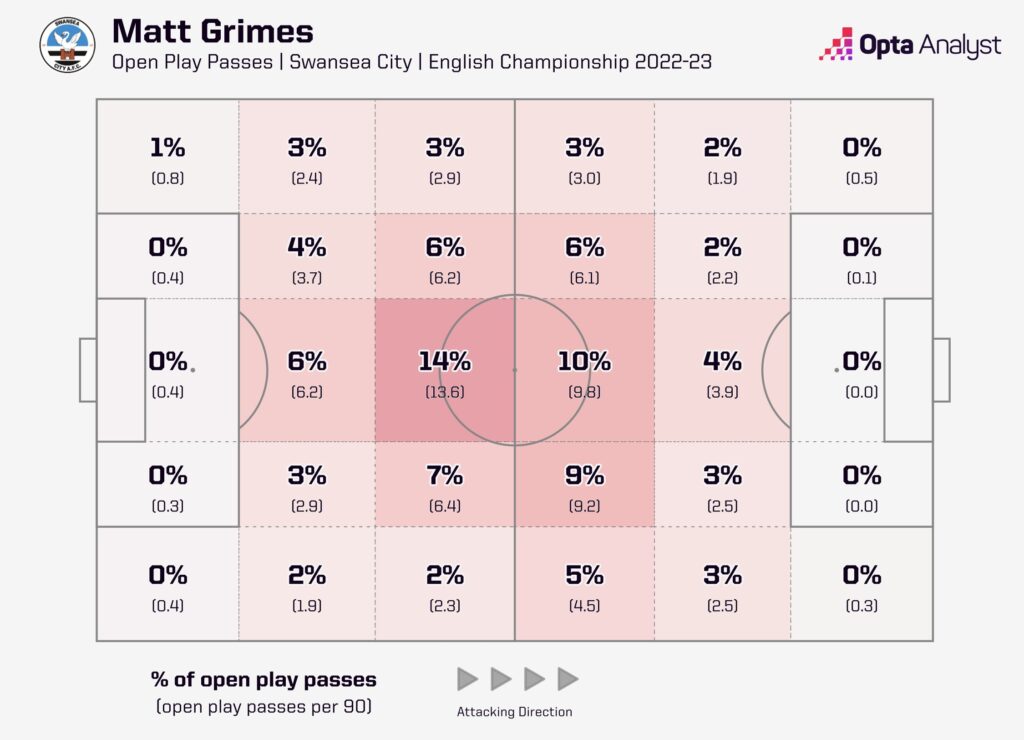
The former Exeter City academy graduate makes 2.4 progressive runs per 90, plays 1.6 through passes and 1.3 successful passes into the penalty area, ranking in the top 50th percentile in each of those metrics.
With a feather touch, ice cool composure and wondrous left foot, the deep-lying playmaker also has a progressive passing accuracy of 83.0%, an overall passing accuracy of 92.7%, and a stunning 81.4% in the final third.
Into his ninth season in this corner of Wales, Grimes has previously been a consistent performer for the Swans, and this year he looks Premier League quality.
The only worry for Swansea would be that if they don’t go up, their key man might attract interest from a bottom half Premier League club such as Burnley (if they were to go up), Crystal Palace or Nottingham Forest.
The Case Against the Defence
If anybody only watched the goals Swansea had conceded this season – not the quality of football they’ve played at times nor the goals they’ve scored – it might have been assumed that they were bottom of the league.
Of course, every team concedes goals and for most of them, there’s things that could have been done differently. But the themes underpinning the ones the Swans have leaked have been consistent.
Sometimes it’s a corner, free-kick or long throw into the box for which there are lots of players in a position to attack the ball, but nobody does: like conceding the opener to Wigan from inside the six-yard box, when they had nine men inside that zone.
In two of their games, Swansea have conceded a goal very similar to another in the same half of football: Wigan at home, and Burnley away, where they didn’t track runners to the back-post twice.
At times, the major goalscoring threat goes inexplicably unmarked, like Troy Deeney for Birmingham.
At other times, there appears to be a yawning chasm in front of the defence which allows opponents to get shots away, and when there has been the personnel to protect, they’ve not always been able to do that job.
Sometimes, that’s been because the midfielders in question simply don’t have the “physical minerals” to be that – see Joe Allen at Middlesbrough – other times, the tracking of runners has been questionable – see Cameron Congrieve and Kyle Naughton at Middlesbrough.
A lot of the time, though, it’s about that raw determination to throw bodies on the line and protect the goal at all costs, or at least a willingness to challenge or block in some small way. In either case, courage in those moments has been lacking all too often.
It might be tempting to look at errors from Darling, Cabango and others as evidence that Swansea’s extreme, possession-heavy methods are to blame for the fact they’ve conceded 38 goals.
Some of the goals the Swans have shipped have come from misplaced passes, or a shortage of numbers in defensive areas, and in those cases, one could argue defensive imperfections have been an occupational hazard for the style Martin has fostered.
And yet, that would be misleading, in terms of the broader picture.
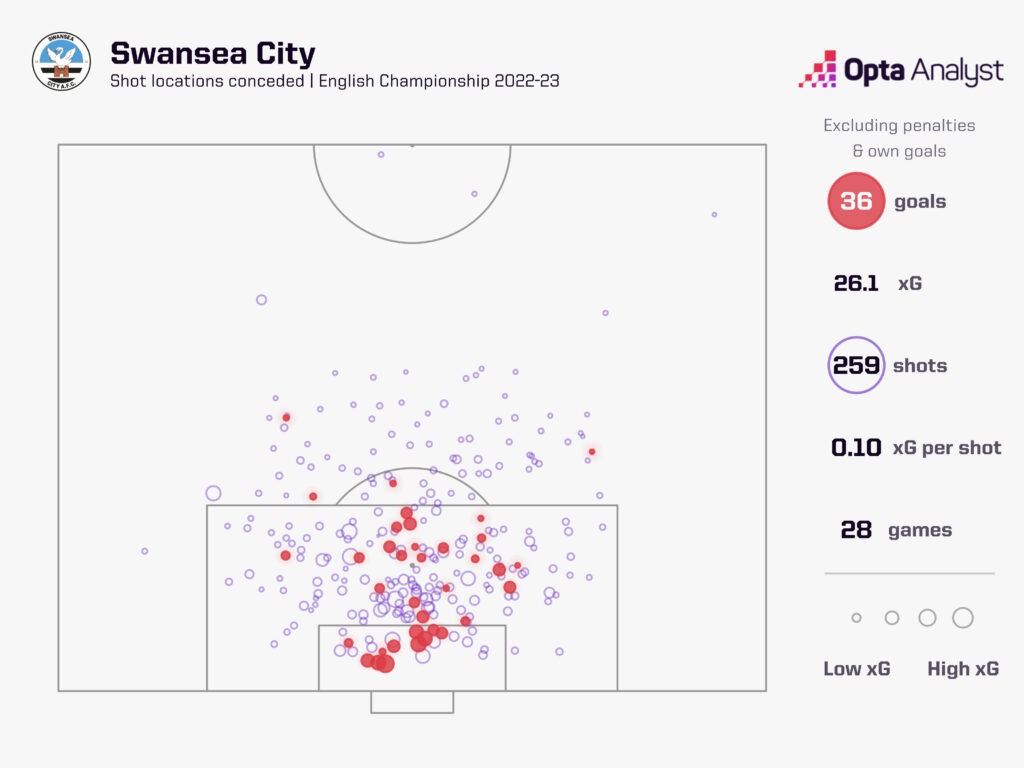
Whilst Swansea have conceded the fifth-highest average non-penalty goals per game (1.36) across the 24-team division, their non-penalty xG average conceded is just 0.93 – the fourth best. Only Wigan (0.50) have conceded more non-penalty goals per game on average above their xG average than Swansea (0.43) in the entire Championship. Have they just been unlucky?
It shouldn’t be unreasonable to expect Swansea to get stronger defensively, whilst retaining their stylistic appeal.
They don’t need to become an outstanding defensive side to finish in the top six – this season or next – they just need to do the basics well.
Win the headers. Push out on second balls. Close down opponents quickly. Get Wood doing some upper-body work. Demand more from Latibeaudiere against the ball. Subtle tweaks which will minimize the concession of cheap goals.
If, over the next 12 months, Martin doesn’t oversee the appropriate changes, then there may be a bigger conversation to be had, because at no point can stylistic principles become an excuse for weak defending.
At the same time, Swansea are at a stage whereby there has been some space for a manager to build towards a clear playing identity without too much pressure.
Martin has certainly delivered progress, built a team that plays some of the best football in the Championship, and earnt the opportunity to make those crucial tweaks in the next phase.
The Future
Russell Martin speaking in today’s pre-match press conference 👇
— Milton Keynes Dons (@MKDonsFC) March 8, 2021
Full press conference to follow on https://t.co/sOMfCkEh7r. pic.twitter.com/2hL8DiyCOq
This is not the first time underlying data tells a different story to results for Russ Martin, who’s MK Dons side topped a lot of League One metrics in 2020-21 yet finished mid-table.
That season, though, was the first one that Martin had a full pre-season to prepare his side at Stadium:MK, after inheriting a relegation dogfight from Paul Tisdale in November of the previous season.
And while the talented coach’s acrimonious exit for Swansea a week before the league season meant he didn’t see the fruits of his labour in 2020-21, but replacement Liam Manning did – MK finished third in League One in 2021-22, with 89 points.
It was argued that Martin and Luke Williams had laid the foundations for that season, and that the achievements had a lot to do with their work, an argument that may have more credence in light of Manning’s struggles this term.
As such, it’s possible that Martin’s management style lends itself to a three-year cycle.
The first would be to get his players acclimatized to his possession-heavy methods, which can be necessary if he’s not had a full summer to work with them.
The second might be progression, in terms of finishing higher, developing the style and creating more chances.
The third, meanwhile, would be success – making the finishing touches to convert an expansive, enterprising outfit into a ruthless, winning machine.
Of course, it’s yet to be seen for sure whether Martin can deliver on that third season, if indeed he needs it.
However, the former Norwich defender won’t need to compromise his principles to deliver success but increase his demands when it comes to the essentials.
Martin has proved an excellent coach, who has developed top level talent whilst fostering an aesthetically appealing style of play. And yet, for all that, the 37-year-old hasn’t yet achieved anything of substance.
Sticking to a unique club style can take you far, and Martin is out to prove that conclusively at Swansea. He’s laid the groundwork. Now he needs to see the true fruits of his labour.
Enjoy this? Subscribe to our mailing list to receive exclusive weekly content.
